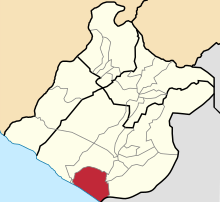[...] on the northwest, [the province] limits with the district of Tacna, the limit begins in the coast, in a UTM coordinate point 333 220 m E and 7 985 129 m N; in the northeast it borders the district of Tacna, in the east it borders the district of Tacna, in the south it borders the Republic of Chile, along the frontier line, until its intersection with the Pacific Ocean in the Concordia milestone, point of beginning of the land border, in accordance with the provisions of the Treaty of Lima and its Supplementary Protocol, between Peru and Chile, dated June 3, 1929, and the work of the Mixed Boundary Commission of 1929 and 1930; and from the west, starting from the Concordia point, starting point of the land border with the Republic of Chile, bordering the Pacific Ocean, following the low tide line to a coordinate point UTM 333 220 m E and 7 985 129 m N, starting point of the present description. All this, also, with respect to the maritime boundary with Chile, defined by the ruling of the International Court of Justice of January 27, 2014 and the coordinates determined by virtue of the work carried out by technicians from both countries, which are included in the Minutes. signed in Lima, on March 25, 2014. [1]
Chile protested against the creation of the district due to the dispute between both countries, and declared it null and void in the context of the border between both states. [2]
